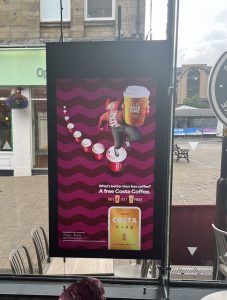How to Give Great Customer Service Using Retail Digital Signage
It’s no secret that in retail customer service is key but according to the Retail Weeks, The Great Service Shortfall – Tackling retail’s new pandemic report, service or product problems are costing UK businesses £9.24bn every month in lost staff time – the highest level since the Institute of Customer Service records began in 2008.
Angus Thirlwell, co-founder and chief executive of Hotel Chocolat says: “During the pandemic, our customers showed us a lot of latitude and tolerance. They knew that businesses were finding it tough to hold it together and they were showing consideration for that.”
Thirlwell added, “Now that, in the UK, it’s post-pandemic, and with the impact of the cost-of-living crisis, there’s been a marked change. Quite rightly, people are looking at every pound that they spend”.
ICS chief executive Jo Causon says: “Many businesses are already struggling to deliver consistent levels of service hampered by staff shortages, supply issues and geopolitical upheaval”. However, more than a third of customers said they would pay more to guarantee excellent service.
So how do we improve customer service levels to gain customer loyalty?
Today’s consumers expect to see technology being used to improve their in-store customer service experience, and digital signage does just that.
Aside from attracting attention and increasing engagement levels, digital signage can give organisations the flexibility of deploying important individual customer communications within seconds. It can also influence purchase decisions, increase brand awareness, reduce print costs and reduce perceived waiting times whilst staff can concentrate on their organisation’s core objectives.
Some of the main uses of retail digital signage to give great customer service are:
Brand messaging/marketing
Digital signage is often used as a tool for displaying important brand messages or raising brand awareness. High-definition graphics and quality imagery can be used to attract the eyes of in-store customers.
Fashion retailers often use digital signage to display a catalogue of images for in-store inspiration and to aid the decision-making process.
Product information and assisted selling
Digital signage can be used to leverage upsells and impulse purchases at the point of sale by displaying important marketing messages associated with a specific product or service.
Signage can often be used to persuade customers into making a purchase decision through direct advertising or offering in-store discounts. Integration with back-end systems can help with stock control by pushing certain SKUs where there is a surplus for meeting in-store sales targets.

Third-party advertising
Fashion outlets can use digital signage to promote third-party advertisements and products. We see the potential for a brokerage-style system where brands can bid for advertising space, which will increase ROI on the adoption of digital signage. For example, a retailer that supplies branded products can give the different brands the option to pay to promote their brand in-store and drive sales.
Reduce perceived waiting times
David Maister, in “The Psychology of Waiting Lines,” says, “Occupied time feels shorter than unoccupied time.” Retailers are employing this logic using digital signage to draw attention away from the wait itself and minimise boredom, offering more professional treatment for customers. By strategically placing digital signage around hotspots where dwell times are longest, relevant messaging can be displayed to entertain and inform customers.
Video walls and large digital displays located at till points provide endless possibilities for retailers to capture the attention of customers waiting in line. Integrating news updates, weather reports and sports events keep customers interested, whilst key business information reinforces brand engagement and company culture.

Entertainment
Digital signage is often used as a method of in-store entertainment, using high-definition animation and video to attract customers’ attention. The native video wall is ideal for displaying promotional videos and can be used as a method of entertaining the companions of in-store shoppers.
Personalisation
Nowadays, consumers expect to receive a highly personable service that is entirely tailored to their needs, shopping habits and previous buying behaviour. A customer can be recognised through facial recognition and interacting with the screen can make a customer’s experience more exciting.
Digital signage allows for content personalisation by allowing organisations to tap into all the data they have about a customer and auto-drive screen content, ultimately turning big data into smart data.

Intrigued about any of the technology in this article to help improve your customer service levels to gain customer loyalty and you would like to contact us? Call our customer support dedicated helpline on 01135 313636 or email us at info@signstix.com.
If you liked reading our blog on How to Give Great Customer Service Using Retail Digital Signage then check out the How Digital Signage Reduces Perceived Wait Times blog.
Check out more blog posts here.
